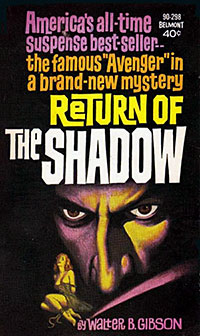 A particular phenomenon of the New Pulp world is of new stories using the original pulp heroes.
A particular phenomenon of the New Pulp world is of new stories using the original pulp heroes.
Of course, this isn’t a new trend. The Shadow got the first new stories when Belmont Books commissioned Walter Gibson to write a new Shadow novel, then got Dennis Lynds to continue to write new Shadow stories, though had him be more of a spy. Warner Brothers soon followed when they had Ron Goulart write new Avenger stories when they ran out of originals to reprint.
Today, we have two groups of new stories of original heroes.
For those characters who are still controlled under copyright (basically the Street & Smith and Popular characters, and a few others), authorized stories are hard to do. Will Murray is the only one doing new Doc Savage novels. Through Moonstone, we have anthologies of authorized new Avenger and Spider stories, which allows for others to try their hand. Not aware of others being so used, but some may be on the way.
For those characters now in the public domain, these are pretty much fair game for anyone. Several publishers do new stories with these characters, such as Airship 27, Wild Cat, Wildside, Pro Se, Altus, and others. Some publishers and authors seem to focus on particular characters. Pro Se has their Pulp Obscura line for particular characters reprinted by Altus Press (such as Thunder Jim Wade, The Eagle, Richard Knight, and others). Airship 27 has had several series on other characters such as the Black Bat, Ravenwood, and others. And both have plans for new ones.
Also, it seems that some authors have gravitated to certain characters, and made them their own. Ron Fortier has done this with Captain Hazzard. Joshua Reynolds seems to have done this with Jim Anthony. Art Sippo has done this with Sun Koh. Others have done the same.
For me, one thing that is important with these stories is that they stay true to the original. I don’t feel that new authors need to slavishly follow the original. I am okay with new things added to the character, adding to their history, (say, adding a possible love interest or creating stories set before or after the original stories) as long as it’s in the spirit of the original.
I am okay with some changes if they fix problems with the original.
Doctor Satan wasn’t used to his full potential, mainly extorting money from people. Barry Reese has dropped this, making him a more sinister character. Christopher Yates is using the Night Wind to his full potential not seen by his original author.
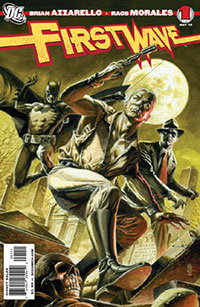 I am not okay with a character being “revamped” to appeal to modern audiences, or because the author finds the character “boring” or the like. Examples of this are many of the modern comic book adaptions of pulp heroes, such as Dynamite’s alteration of the Black Bat. Or DC’s First Wave travesty of both Doc Savage and The Avenger.
I am not okay with a character being “revamped” to appeal to modern audiences, or because the author finds the character “boring” or the like. Examples of this are many of the modern comic book adaptions of pulp heroes, such as Dynamite’s alteration of the Black Bat. Or DC’s First Wave travesty of both Doc Savage and The Avenger.
I have generally seen that when it comes to new prose stories, they are more likely to be true to the original than new comic stories. It seems those who write New Pulp prose stories are better fans of pulps and wish to stay true to the character than comic book writers. Don’t know why.
Whenever I see new stories of classic characters, I would prefer to read the originals first, so I can get a sense or understanding of the originals. Sadly, that’s not always possible. I’ve yet to read any original Moon Man stories, though I’ve read many new ones. I will probably never get a chance to read original Sun Koh stories. But that’s my preference.
When I approach new stories, I always use the above guideline when I judge those new stories: Is the story true to the character, even if there are changes? This is what colors my reviews of those works. You will see this view used here.
If you as a writer can’t be true to the original, then please don’t bother using the original character. Create your own. Create a pastiche or analogue, if need be. Pulp fans will probably be more accepting of an original character or even a pastiche that goes in a different direction than of you misusing an original. The pulp-inspired comic book Incognito was much more accepted because they created Doc and Shadow analogues rather than if the author had tried using the original characters. By doing analogues, he could use them in ways that worked for him, but could be enjoyed by pulp fans.
What is your take on new stories from old characters?

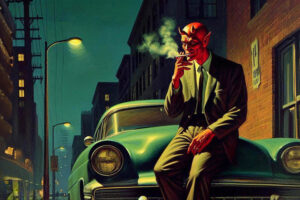
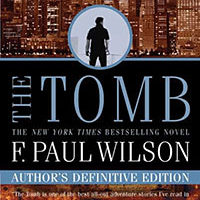
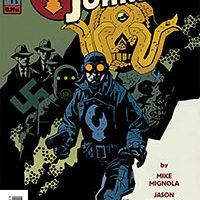
I’m in complete agreement, Michael. I prefer the tone and intention of the originals. And, as long as new creators stick close to that, I love reading new tales.
My …disdain and aggravation, for mangling established heroes by new creators/producers knows no bounds. Doesn’t matter if it’s DC mishandling Doc Savage (again) or Hollyweird “updating” classic characters. Ugh.
Well said, Michael.
Bobby
Don’t forget my new Green Lama works coming from Moonstone!
Back in the 1970s, when series such as Doc Savage, The Shadow, and The Avenger were in their heyday of mass-market paperback reprints, there was still a sense of history and reverence for the past among the comic book audience. Thus we saw the Street & Smith heroes adapted fairly faithfully along with a resurgence in fantasy & SF pulp heroes from Burroughs, Robert E. Howard, etc. With the exception of Conan, however, none of these characters was sustainable in the marketplace for long.
Nowadays the common wisdom seems to be that these characters must change to fit a new audience that doesn’t have the reverence for history that an earlier comic book fandom did. But in a way, even that idea is not particularly new, going back to Jerry Siegel’s 1965 adaptation of The Shadow for Archie Comics, updated to superhero mode as sort of a cross between Batman and Professor X. We can go back even further to the many adaptations to comics of pulp heroes that came from the same publishers responsible for the pulps themselves, particularly Nedor/Better/Standard and Street & Smith (who published the hooded, ruby-powered comic book Doc Savage at the same time they were publishing a more subdued, and toned-down from his pre-war exploits, Doc Savage in the pulps). Few of these were particularly faithful to the original novels. If you were a fan of The Shadow Magazine in the 1930s, you’d be complaining about this new upstart radio show that wasn’t faithful to the Shadow as he was being portrayed in the magazines (and many of them wrote letters to the editor to that effect). Long story short, there’s nothing new in bending and reshaping these characters to fit the molds of different mediums.
The sad fact of the matter is, whether the comic book adaptations of today are more or less faithful to the original characters, they all seem to struggle for acceptance and sales in the marketplace, and few have achieved long runs. Perhaps they really are better off sticking with the ‘pulp-inspired’ characters like the Rocketeer, Black Beetle and Lobster Johnson (which certainly also draw influence from the newspaper adventure comics, Golden Age comics, and movie serials as well) in the long run.
On reflection, it’s helpful to pause and consider that the entire ‘hero pulp’ genre was kicked off by the enormous success of The Shadow Magazine, itself an ‘UNfaithful adaptation’ of the narrator character of the radio Street & Smith’s Detective Story Hour. Had Walter Gibson hewed closer to the radio model, perhaps S&S would have simply retitled its existing Detective Story Magazine as ‘The Shadow Detective Story Magazine’ and the resultant product would have more closely resembled a prose version of the comic book Crime Does Not Pay (hosted by Mr. Crime) or Tales From the Crypt (hosted by the Crypt-Keeper).